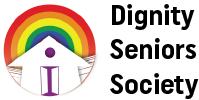Dignity Seniors Society has adapted a modle designed by the Seniors Pride NetworkToronto and the See/Hear/Feel Model. Please consult with us if you have any questions or doubt about how to implement these in your facility.
Governance
· Policies and strategies are created and communicated to senior staff to the needs, strengths and priorities of 2SLGBTQ+ clients/communities.
Communications
· Written and graphic materials are welcoming and inclusive of 2SLGBTQ+ residents, families, volunteers and staff.
· 2SLGBTQ+ people are consulted about their needs and issues and are able to register concerns or complaints.
Community Relations
· 2SLGBTQ+ people and organizations are sought out and welcomed as participants in the daily life of the homes.
· The facilities celebrate significant 2SLGBTQ+ events with the community.
Physical Facility and Environmental Design
· Design and decor provide a welcoming environment for 2SLGBTQ+ communities.
· Care and attention to safety are shown in selecting room-mates or in the sharing of facilities
Programs and Services:
· Are designed to meet the physical, social, emotional, and spiritual needs of 2SLGBTQ+residents.
· Are delivered with sensitivity to the history of oppression of 2SLGBTQ+ people
Human Resources
· Includes robust antidiscrimination and anti-harassment policies.
· Creates hiring policies to welcome and promote people from LGBT communities
See/Hear/Feel Model
See: In the physical environment, is there evidence of positive signs and symbols displayed throughout the home:
❑ Written, graphic materials, images, artwork and signage welcomes and are inclusive of 2SLGBTQ+ people to the home. This could include displays of the rainbow flag, images of same-sex couples, posters and information relevant to the local 2SLGBTQ+ community, display of the homes participation at the Pride Parade, announcements of upcoming community meetings with 2SLGBTQ+ inclusive local agencies, as examples;
❑ 2SLGBTQ+ literature and materials, such as newspapers, magazines and brochures are accessible in common areas of the home, i.e., front lobby sitting area, a 2SLGBTQ+ section in the homes library, 2SLGBTQ+ themed movies and DVDs, inclusion and announcements of 2SLGBTQ+ programs and services being offered in the home are included in newsletters;
❑ Written materials offered to the public clearly reflect non-discrimination policies and practices and reflects a 2SLGBTQ+ welcoming environment. This would include information provided to the public during tours of the home
❑ Programs with an 2SLGBTQ+ focus or interest are advertised or promoted through the resident newsletter, posted in the home and/or announced as a special program; and
❑ Promotional material prepared by the home, i.e., fact sheet and informational material for other health and social services professionals reflects the homes initiative to provide a 2SLGBTQ+ welcoming environment.
Hear: The language heard within the home reflects inclusion:
❑ Written forms and assessments do not assume heterosexuality as the norm, i.e., the use of partner instead of husband/wife and have multiple options for pronouns;
❑ There is a broad definition of family and partner to include “family of choice;”
❑ Staff and volunteers are knowledgeable and comfortable in the use of inclusive language and it is reflected in their language in day-to-day discussions
Feel: The environment gives a sense of being safe and affirming:
❑ 2SLGBTQ+ residents and their families and friends identity is acknowledged, affirmed and respected;
❑ There is recognition of residents/family rights and reminders that the home is a safe place. An example of this would include the care and attention taken by the home in selecting roommates or in the sharing of the facilities’ common spaces. This holds particularly important and affirming for older 2SLGBTQ+ adults receiving care and services;
❑ There are accessible and supportive processes available in the home that allows residents, family, volunteers and staff to raise issues and concerns, feel that they are heard and that issues will be followed-up on and mechanisms to ensure two-way communication.
While physical safety is an important aspect in ensuring that the environment is 2SLGBTQ+ welcoming, it is equally important to consider the aspect of privacy and understand the special importance it can mean to 2SLGBTQ+ individuals.

